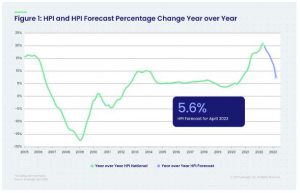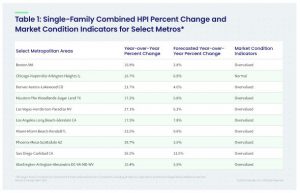US Home Price Gains Continue to Soar in April as Rising Mortgage Rates Drive Buyer Urgency, CoreLogic Reports

CoreLogic, a leading global property information, analytics and data-enabled solutions provider, today released the CoreLogic Home Price Index (HPI™) and HPI Forecast™ for April 2022.
Nationwide, home prices posted another record-high year-over-year increase in April, marking the 123rd straight month of gains. Rising mortgage rates drove buyer urgency and the resulting price growth, with about 70% of U.S. homes selling for more than asking price this spring. However, higher mortgage rates will likely also put the brakes on buyer demand in the coming months, causing annual home price appreciation to cool to 5.6% by April 2023.
“The record growth in home prices is a result of a scarcity of for-sale inventory coupled with eager buyers who want to purchase before mortgage rates go higher,” said Patrick Dodd, president and CEO at CoreLogic. “Most buyers who closed on their home in April had locked in their mortgage rate in February or March when rates were lower than today. With 30-year fixed mortgage rates much higher now, we expect to see waning buyer activity because of eroding affordability. Consequently, our forecast projects slowing price growth over the coming year.”
Top Takeaways:
- U.S. home prices (including distressed sales) increased 20.9% in April 2022, compared to April 2021. On a month-over-month basis, home prices increased by 2.6% compared to March 2022.
- In April, annual appreciation of detached properties (21.8%) was 4 percentage points higher than that of attached properties (17.8%).
- Annual U.S. home price gains are forecast to slow to 5.6% by April 2023 as rising mortgage rates and affordability challenges impede buyer demand.
- As in March’s HPI, Tampa, Florida logged the highest year-over-year home price increase of the country’s 20 largest metro areas in April, at 33.1%. Phoenix again ranked second, with a 29.7% year-over-year gain. On the lower end of the price growth spectrum was New York, at 9.8%. New York was one of the major U.S. metros that lost population in 2021, which is likely contributing to the sluggish price growth when compared with other areas.
- Florida and Arizona posted the highest home price gains, a respective 32.4% and 28.1%. Tennessee ranked third with a 27.2% year-over-year increase. These three states also saw the nation’s highest annual appreciation in March.
The next CoreLogic HPI press release, featuring May 2022 data, will be issued on July 5, 2022, at 8 a.m. ET.
Methodology
The CoreLogic HPI™ is built on industry-leading public record, servicing and securities real-estate databases and incorporates more than 45 years of repeat-sales transactions for analyzing home price trends. Generally released on the first Tuesday of each month with an average five-week lag, the CoreLogic HPI is designed to provide an early indication of home price trends by market segment and for the “Single-Family Combined” tier, representing the most comprehensive set of properties, including all sales for single-family attached and single-family detached properties. The indices are fully revised with each release and employ techniques to signal turning points sooner. The CoreLogic HPI provides measures for multiple market segments, referred to as tiers, based on property type, price, time between sales, loan type (conforming vs. non-conforming) and distressed sales. Broad national coverage is available from the national level down to ZIP Code, including non-disclosure states.
CoreLogic HPI Forecasts™ are based on a two-stage, error-correction econometric model that combines the equilibrium home price—as a function of real disposable income per capita—with short-run fluctuations caused by market momentum, mean-reversion, and exogenous economic shocks like changes in the unemployment rate. With a 30-year forecast horizon, CoreLogic HPI Forecasts project CoreLogic HPI levels for two tiers — “Single-Family Combined” (both attached and detached) and “Single-Family Combined Excluding Distressed Sales.” As a companion to the CoreLogic HPI Forecasts, Stress-Testing Scenarios align with Comprehensive Capital Analysis and Review (CCAR) national scenarios to project five years of home prices under baseline, adverse and severely adverse scenarios at state, metropolitan areas and ZIP Code levels. The forecast accuracy represents a 95% statistical confidence interval with a +/- 2% margin of error for the index.
About Market Risk Indicator
Market Risk Indicators are a subscription-based analytics solution that provide monthly updates on the overall “health” of housing markets across the country. CoreLogic data scientists combine world-class analytics with detailed economic and housing data to help determine the likelihood of a housing bubble burst in 392 major metros and all 50 states. Market Risk Indicators is a multi-phase regression model that provides a probability score (from 1 to 100) on the likelihood of two scenarios per metro: a >10% price reduction and a = 10% price reduction. The higher the score, the higher the risk of a price reduction.
About the Market Condition Indicators
As part of the CoreLogic HPI and HPI Forecasts offerings, Market Condition Indicators are available for all metropolitan areas and identify individual markets as “overvalued”, “at value”, or “undervalued.” These indicators are derived from the long-term fundamental values, which are a function of real disposable income per capita. Markets are labeled as overvalued if the current home price indexes exceed their long-term values by greater than 10%, and undervalued where the long-term values exceed the index levels by greater than 10%.
Contact:
Robin Wachner – Media Contact – newsmedia@corelogic.com
Source: CoreLogic, Inc.




